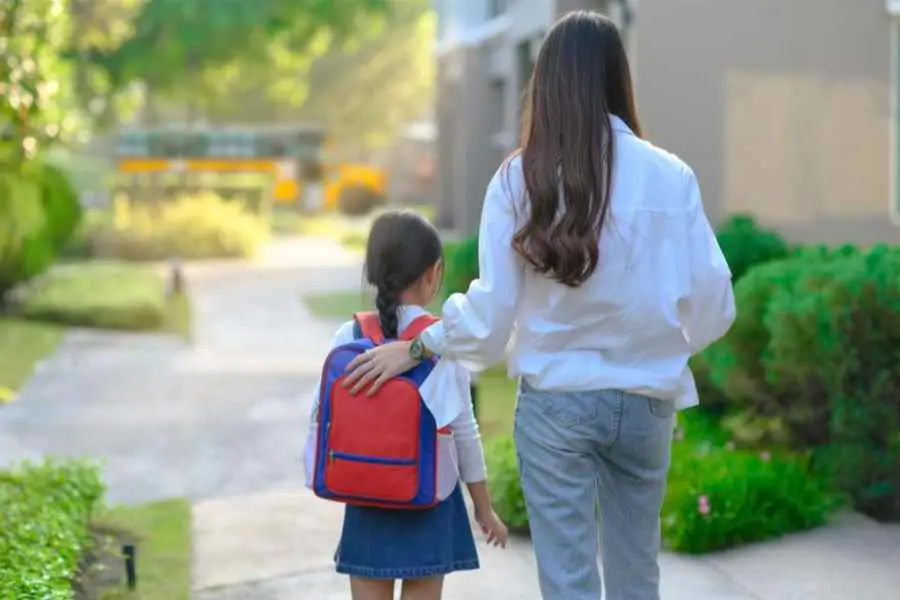Back to School Anxiety & Sleep: A Smooth Transition

Summer is one of my favorite times of year because it typically means warmer weather, a more relaxed routine, and plenty of time for connection with family and friends. With all that fun, the end of summer can be a bit tough as we get back into the busy schedule of the year. For our children, returning to daycare or school can also bring about some anxiety. As I prepare for my oldest to start first grade this fall, I thought it would be the perfect time to explore how I can help her manage her angst. I hope you find these strategies helpful for your family as well.
Just like adults, children can worry about the future, and we all know the time of day when worry tends to creep in the most: bedtime. When our bodies are still and we aren’t distracted by the activities of the day, our brains can fixate on “all the things.” With school approaching, many of our kids may start to worry about what school will be like. Of course, this is all natural, but as natural as it is, there are strategies we can use to manage these thoughts so that they can still obtain a good night’s rest.
Establish a Routine
If you’ve worked with me before, you know how important a bedtime routine is for your child. As you prepare for back to school, be sure to reestablish the bedtime routine with an appropriate bedtime 1-2 weeks before school starts. This will allow your child to transition back to the school schedule with as little stress as possible. Move bedtime 15 minutes earlier every 3-4 days until you’ve reached the ideal bedtime. The routine leading to bedtime should be 20-30 minutes with predictable steps that cue their brains that sleep is on the horizon.
Visit the School
Take some time to visit the school grounds a few weeks before school starts. Check out the playground and show them the front entrance. This allows them to familiarize themselves with the environment and gives them context on what to expect. This is particularly helpful if the school they are attending is new to them this year (as is the case with my daughter!).
Connect with Your Child
Build in 1:1 time with your child every day. Schedule a 10-minute block of time free of screens to share in conversation or a special activity (coloring, reading, or even taking a short walk). This time gives them an opportunity to share their feelings and allows you to identify their anxiety triggers.
Set a “Worry Time”
If you notice that your child is expressing worry at a certain time of day or find that they are worrying throughout the day, consider setting a specific worry time. Try this script: “I know you are a little nervous to start school. We are heading to summer camp this morning, so I want to make sure we set a time to talk more about this. 4 pm is our ‘worry time,’ and we will chat more about why you are nervous and what we can do about it. Sound like a plan?” This acknowledges their feelings but also gives them a set time later in the day to address it so that worry doesn’t overcome the day and interfere with other scheduled activities.
Arrange Peer Play Dates
Arrange some play dates with peers who will attend the same school before school starts. Research shows that the presence of familiar peers during the transition back to school can ease anxiety by providing a sense of security and familiarity. These interactions allow children to build friendships and establish a support network, making the new school environment feel less intimidating.
Encourage Physical Activity
The WHO recommends physical activity for young children. In addition to the vast benefits of physical activity on general health, there is also a significant impact on sleep. Exposure to daylight boosts melatonin production, and activity gets the body moving and burns energy, which leads to an easier transition into overnight sleep.
Engage and Praise
As adults, we understand that the anxiety of back to school is only one of many situations our children will experience that may make them uncomfortable. Instead of trying to bypass these emotions, face them head-on and praise them after they manage their fear. A simple “I’m so proud of you for walking into the classroom alone today” can provide significant reassurance to your child and boost their confidence. Praising them after challenges is a great way to build resilience.
These seven tips can guide you as you make the transition back to school. A plan to ease anxiety and promote adequate rest will lay a foundation not just for your child, but for your entire family. Remember, a well-rested and less anxious child is more likely to thrive academically, socially, and emotionally throughout the school year.